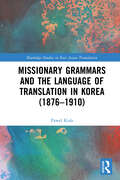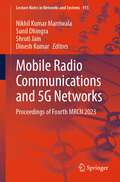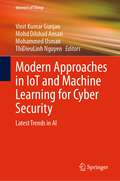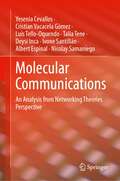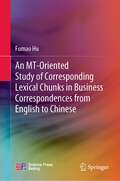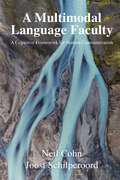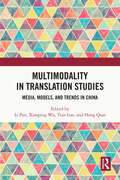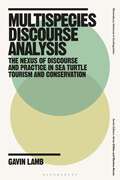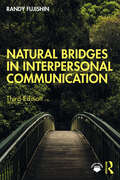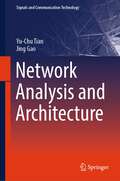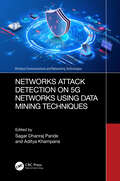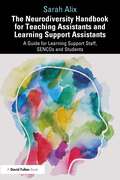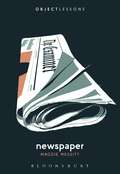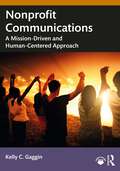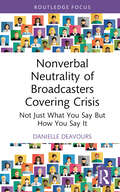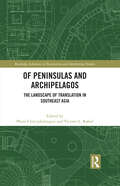- Table View
- List View
Missionary Grammars and the Language of Translation in Korea (Routledge Studies in East Asian Translation)
by Paweł KidaMissionary Grammars and the Language of Translation in Korea (1876−1910) embraces the Enlightenment period in Korea (1876−1910) after the opening of the so-called Hermit Nation in describing the Korean language and missionary works.This book includes a comprehensive analysis and description of works published at that time by John Ross (1877, 1882), Felix-Clair Ridel (1881), James Scott (1887, 1893), Camille Imbault-Huart (1893), Horace Grant Underwood (1890, 1914), James Scrath Gale (1894, 1903), and Annie Laurie Baird (1911) with the particular focus on missionary activities, linguistic practices, grammatical content, and the language of translation from Korean into a native language. The topic of missionary grammar was raised by Otto Zwartjes (2012, 2018) with a focus on South America, North America, and Portuguese missions in Asia and Africa. Still, so far, Korea had not been mentioned, and there has been missing content about missionary grammar in Korea. A necessary study has been made within the framework of AMG (Average Missionary Grammar). The author has concluded that missionary works played an essential role in the formation of further linguistic research in Korea. The Greek-Latin approach applied by Western missionaries to the language is still relevant in the grammatical description of the Korean language.This book will primarily appeal to Korean language educators, researchers, and historical linguists. Postgraduates interested in missionary grammar will also benefit from the content of this volume.
Mobile Communication in Asian Society and Culture: Continuity and Changes across Private, Organizational, and Public Spheres
by Ming Xie Chin-Chung ChaoXie and Chao present a collection of research on mobile communication in Asian communities and countries such as Bangladesh, China, India, Japan, and South Korea. With chapters written by scholars from diverse cultural and institutional backgrounds, this book provides both localized and comparative perspectives on mobile communication research. Exploring the way mobile apps are used in daily life in Asian countries, Xie, Chao, and their contributors analyze how mobile apps improve lives, help people build relationships, sustain communities, and change society for the better. They look at areas including the role of mobile apps in public service delivery and access, family communication, cultural norms and identities, organizational communication, and intercultural communication. The investigation of these topics elevates the understanding of the cultural, familial, interpersonal, organizational, and intercultural consequences of mobile communication in a global context. Through examining mobile apps use in regard to scale, scope, depth, complexity, and distinctiveness within the Asian context, this book furthers the research agenda of mobile communication and enriches our understanding of current practice and future direction of mobile communication. This book serves as a useful reference for scholars and students interested to learn more of the development and application of mobile communication from a global and comparative perspective.
Mobile Communication in Asian Society and Culture: Continuity and Changes across Private, Organizational, and Public Spheres
by Ming XieXie and Chao present a collection of research on mobile communication in Asian communities and countries such as Bangladesh, China, India, Japan, and South Korea. With chapters written by scholars from diverse cultural and institutional backgrounds, this book provides both localized and comparative perspectives on mobile communication research. Exploring the way mobile apps are used in daily life in Asian countries, Xie, Chao, and their contributors analyze how mobile apps improve lives, help people build relationships, sustain communities, and change society for the better. They look at areas including the role of mobile apps in public service delivery and access, family communication, cultural norms and identities, organizational communication, and intercultural communication. The investigation of these topics elevates the understanding of the cultural, familial, interpersonal, organizational, and intercultural consequences of mobile communication in a global context. Through examining mobile apps use in regard to scale, scope, depth, complexity, and distinctiveness within the Asian context, this book furthers the research agenda of mobile communication and enriches our understanding of current practice and future direction of mobile communication. This book serves as a useful reference for scholars and students interested to learn more of the development and application of mobile communication from a global and comparative perspective.
Mobile Radio Communications and 5G Networks: Proceedings of Fourth MRCN 2023 (Lecture Notes in Networks and Systems #915)
by Dinesh Kumar Shruti Jain Nikhil Kumar Marriwala Sunil DhingraThis book features selected high-quality papers from the Forth International Conference on Mobile Radio Communications and 5G Networks (MRCN 2023), held at University Institute of Engineering and Technology, Kurukshetra University, Kurukshetra, India, during August 25–26, 2023. The book features original papers by active researchers presented at the International Conference on Mobile Radio Communications and 5G Networks. It includes recent advances and upcoming technologies in the field of cellular systems, 2G/2.5G/3G/4G/5G, and beyond, LTE, WiMAX, WMAN, and other emerging broadband wireless networks, WLAN, WPAN, and various home/personal networking technologies, pervasive and wearable computing and networking, small cells and femtocell networks, wireless mesh networks, vehicular wireless networks, cognitive radio networks and their applications, wireless multimedia networks, green wireless networks, standardization of emerging wireless technologies, power management and energy conservation techniques.
Modern Approaches in IoT and Machine Learning for Cyber Security: Latest Trends in AI (Internet of Things)
by Vinit Gunjan Mohd Ansari Mohammed Usman ThiDieuLinh NguyenThis book examines the cyber risks associated with Internet of Things (IoT) and highlights the cyber security capabilities that IoT platforms must have in order to address those cyber risks effectively. The chapters fuse together deep cyber security expertise with artificial intelligence (AI), machine learning, and advanced analytics tools, which allows readers to evaluate, emulate, outpace, and eliminate threats in real time. The book’s chapters are written by experts of IoT and machine learning to help examine the computer-based crimes of the next decade. They highlight on automated processes for analyzing cyber frauds in the current systems and predict what is on the horizon. This book is applicable for researchers and professionals in cyber security, AI, and IoT.
Molecular Communications: An Analysis from Networking Theories Perspective
by Yesenia Cevallos Cristian Vacacela Gómez Luis Tello-Oquendo Talia Tene Deysi Inca Ivone Santillán Albert Espinal Nicolay SamaniegoThis book provides a complete analysis of molecular communications systems from the paradigm of TCP/IP network stack, and it exploits network theories (e.g. independent functions of a layer into a stack, addressing, flow control, error control, and traffic control) and applies them to biological systems. The authors show how these models can be applied in different areas such as industry, medicine, engineering, biochemistry, biotechnology, computer sciences, and other disciplines. The authors then explain how it is possible to obtain enormous benefits from these practices when applied in medicine, such as enhancing current treatment of diseases and reducing the side effects of drugs and improving the quality of treatment for patients. The authors show how molecular communications systems, in contrast to existing telecommunication paradigms, use molecules as information carriers. They show how sender biological nanomachines (bio-nano machines) encode data on molecules (signal molecules) and release the molecules into the environment. They go on to explain how the molecules then travel through the environment to reach the receiver bio-nano machines, where they biochemically react with the molecules to decipher information. This book is relevant to those studying telecommunications and biomedical students, engineers, masters, PhDs, and researchers.
An MT-Oriented Study of Corresponding Lexical Chunks in Business Correspondences from English to Chinese
by Fumao HuThis book sheds new light on chunk in business correspondence in order to promote the advancement of machine translation. By presenting a bilingual chunk table for correspondence and providing basic theoretical and empirical data on the construction of an MT-based English-Chinese chunk bank for business correspondence, it seeks to improve the accuracy of machine translation systems in a new way. It mainly addresses two questions: (1) How can business English correspondence chunks be defined in machine translation? (2) What are the correspondences between English-Chinese business letter chunks for machine translation? With the aid of a parallel corpus, qualitative and quantitative research methods, and the construction grammar theory, the book puts forward a theoretical model of chunk composition analysis. Further, the findings presented here can be used for the machine translation of English-Chinese business letters, helping to break down communication barriers and promote international business and exchanges.
A Multimodal Language Faculty: A Cognitive Framework for Human Communication
by Dr Neil Cohn Joost SchilperoordNatural human communication is multimodal. We pair speech with gestures, and combine writing with pictures from online messaging to comics to advertising. This richness of human communication remains unaddressed in linguistic and cognitive theories which maintain traditional amodal assumptions about language. What is needed is a new, multimodal paradigm. This book posits a bold reorganization of the structures of language, and heralds a reconsideration of its guiding assumptions. Human expressive behaviors like speaking, signing, and drawing may seem distinct, but they decompose into similar cognitive building blocks which coalesce in emergent states from a singular multimodal communicative architecture. This cognitive model accounts for unimodal and multimodal expression across all of our modalities, providing a “grand unified theory” that incorporates insights from formal linguistics, cognitive semantics, metaphor theory, Peircean semiotics, sign language, gesture, visual language, psycholinguistics, and cognitive neuroscience. Such a perspective reconfigures how we understand linguistic structure, diversity, universals, innateness, relativity, and evolution. A Multimodal Language Faculty directly confronts centuries-old notions of language and offers a compelling reimagination of what language is and how it works.
Multimodality in Translation Studies: Media, Models, and Trends in China
by Li Pan Xiaoping Wu Tian Luo Hong QianFocusing on multimodality in translation studies, this edited volume provides insights into the trends and practices of multimodal translation in a variety of media. Divided into four main themes, the book explores audiovisual translation in digital media, multimodal translation of Chinese classics, multimodal design in website translation, and the use of paratexts in conference interpreting. Contributors draw on a diverse range of methods and theoretical models, including systemic functional multimodal discourse analysis, narrative theory, Skopos-functional theory, multimodal analysis of digital discourse, and corpus-based multimodal analysis. It covers important topics in media translation, ranging from emerging multimodal translation models to multimodal creativity in interlingual subtitling for social media and identity construction in the multimodal translation of food advertising. Through robust empirical studies, the book aims to shed light on the methodological development of multimodal translation in different media forms, including social media, websites, on-site interactions and books. The title will be of great value to scholars and students of linguistics, translation studies, multimodal discourse analysis and digital media.
Multimodality in Translation Studies: Media, Models, and Trends in China
Focusing on multimodality in translation studies, this edited volume provides insights into the trends and practices of multimodal translation in a variety of media. Divided into four main themes, the book explores audiovisual translation in digital media, multimodal translation of Chinese classics, multimodal design in website translation, and the use of paratexts in conference interpreting. Contributors draw on a diverse range of methods and theoretical models, including systemic functional multimodal discourse analysis, narrative theory, Skopos-functional theory, multimodal analysis of digital discourse, and corpus-based multimodal analysis. It covers important topics in media translation, ranging from emerging multimodal translation models to multimodal creativity in interlingual subtitling for social media and identity construction in the multimodal translation of food advertising. Through robust empirical studies, the book aims to shed light on the methodological development of multimodal translation in different media forms, including social media, websites, on-site interactions and books. The title will be of great value to scholars and students of linguistics, translation studies, multimodal discourse analysis and digital media.
Multispecies Discourse Analysis: The Nexus of Discourse and Practice in Sea Turtle Tourism and Conservation (Bloomsbury Advances in Ecolinguistics)
by Dr Gavin LambThis book explores how language and communication shape the increasingly entangled lives of people and sea turtles at the nexus of sea turtle conservation and ecotourism. Here, new ecocultural identities are taking shape as people strive to make sense of their shifting multispecies landscape, and as sea turtles gradually reclaim beaches after decades of absence. The book offers researchers in ecolinguistics and related ecologically engaged fields in discourse analysis an integrative theoretical and methodological approach to empirically investigate the human and 'more-than-human' discourses and practices shaping problematic human-wildlife interaction. Containing short vignettes in each chapter covering the biology and behaviours of sea turtles, this book suggests how discourse analysts might contribute to a 'life-sustaining multispecies ethics' in an uncertain socio-ecological time increasingly being referred to as the Anthropocene.
Natural Bridges in Interpersonal Communication
by Randy FujishinWith a particularly student-friendly and engaging style, this third edition gives readers the fundamental tools necessary to effectively communicate in interpersonal interactions. Natural Bridges in Interpersonal Communication, Third Edition, is a concise and practical book that introduces students to the basic concepts and skills of interpersonal communication in both face-to-face and online interactions in personal and professional settings. Each chapter features human interest stories and review exercises to help students better understand the concepts covered. This edition continues its expanded coverage of foundational research and devotes additional space to discussions of cultural safety, race and ethnicity, issues of mental health, and technology and social media. This textbook is designed for communication studies, business, and career and trade courses in interpersonal communication and communication skills at the community college and four-year university levels. Online instructor materials that accompany the book include an instructor’s manual, sample exams, and a sample class schedule. They are available at www.routledge.com/9781032355054.
Natural Bridges in Interpersonal Communication
by Randy FujishinWith a particularly student-friendly and engaging style, this third edition gives readers the fundamental tools necessary to effectively communicate in interpersonal interactions. Natural Bridges in Interpersonal Communication, Third Edition, is a concise and practical book that introduces students to the basic concepts and skills of interpersonal communication in both face-to-face and online interactions in personal and professional settings. Each chapter features human interest stories and review exercises to help students better understand the concepts covered. This edition continues its expanded coverage of foundational research and devotes additional space to discussions of cultural safety, race and ethnicity, issues of mental health, and technology and social media. This textbook is designed for communication studies, business, and career and trade courses in interpersonal communication and communication skills at the community college and four-year university levels. Online instructor materials that accompany the book include an instructor’s manual, sample exams, and a sample class schedule. They are available at www.routledge.com/9781032355054.
Network Analysis and Architecture (Signals and Communication Technology)
by Yu-Chu Tian Jing GaoThis book covers network analysis and architecture for large-scale computer network planning. Networks and the Internet are essential for modern industries and societies. Building a new network, upgrading an existing network, or planning to use a public network requires integrating various network mechanisms and technologies in a cohesive fashion. This demands a deep understanding of the concepts, principles, processes, approaches, and good practices of advanced network planning. More specifically, emphasizing service-based networking, the book introduces structured processes for network planning, provides systematic approaches for network analysis and architecture, develops network planning specifications, and discusses high-level network architectural models from various perspectives. It also offers detailed discussions on component-based architecture about addressing, routing, performance, management, and security and privacy. Recent developments in data centers, virtualization, and cloud are also embedded into the network architecture. Moreover, the book includes a comprehensive introduction to building practical TCP/IP network communications via sockets with practical examples. The book is suitable for use as a textbook for senior undergraduate and postgraduate students or as a reference book for network practitioners looking to develop or enhance their skills in network planning.
Networks Attack Detection on 5G Networks using Data Mining Techniques (Wireless Communications and Networking Technologies)
Artificial intelligence (AI) and its applications have risen to prominence as one of the most active study areas in recent years. In recent years, a rising number of AI applications have been applied in a variety of areas. Agriculture, transportation, medicine, and health are all being transformed by AI technology. The Internet of Things (IoT) market is thriving, having a significant impact on a wide variety of industries and applications, including e-health care, smart cities, smart transportation, and industrial engineering. Recent breakthroughs in artificial intelligence and machine learning techniques have reshaped various aspects of artificial vision, considerably improving the state of the art for artificial vision systems across a broad range of high-level tasks. As a result, several innovations and studies are being conducted to improve the performance and productivity of IoT devices across multiple industries using machine learning and artificial intelligence. Security is a primary consideration when analyzing the next generation communication network due to the rapid advancement of technology. Additionally, data analytics, deep intelligence, deep learning, cloud computing, and intelligent solutions are being employed in medical, agricultural, industrial, and health care systems that are based on the Internet of Things. This book will look at cutting-edge Network Attacks and Security solutions that employ intelligent data processing and Machine Learning (ML) methods.This book: Covers emerging technologies of network attacks and management aspects. Presents artificial intelligence techniques for networks and resource optimization, and toward network automation, and security. Showcases recent industrial and technological aspects of next-generation networks Illustrates artificial intelligence techniques to mitigate cyber-attacks, authentication, and authorization challenges. Explains smart, and real-time monitoring services, multimedia, cloud computing, and information processing methodologies in 5G networks. It is primarily for senior undergraduates, graduate students and academic researchers in the fields of electrical engineering, electronics and communication engineering, computer engineering, and information technology.
Networks Attack Detection on 5G Networks using Data Mining Techniques (Wireless Communications and Networking Technologies)
by Sagar Dhanraj Pande Aditya KhampariaArtificial intelligence (AI) and its applications have risen to prominence as one of the most active study areas in recent years. In recent years, a rising number of AI applications have been applied in a variety of areas. Agriculture, transportation, medicine, and health are all being transformed by AI technology. The Internet of Things (IoT) market is thriving, having a significant impact on a wide variety of industries and applications, including e-health care, smart cities, smart transportation, and industrial engineering. Recent breakthroughs in artificial intelligence and machine learning techniques have reshaped various aspects of artificial vision, considerably improving the state of the art for artificial vision systems across a broad range of high-level tasks. As a result, several innovations and studies are being conducted to improve the performance and productivity of IoT devices across multiple industries using machine learning and artificial intelligence. Security is a primary consideration when analyzing the next generation communication network due to the rapid advancement of technology. Additionally, data analytics, deep intelligence, deep learning, cloud computing, and intelligent solutions are being employed in medical, agricultural, industrial, and health care systems that are based on the Internet of Things. This book will look at cutting-edge Network Attacks and Security solutions that employ intelligent data processing and Machine Learning (ML) methods.This book: Covers emerging technologies of network attacks and management aspects. Presents artificial intelligence techniques for networks and resource optimization, and toward network automation, and security. Showcases recent industrial and technological aspects of next-generation networks Illustrates artificial intelligence techniques to mitigate cyber-attacks, authentication, and authorization challenges. Explains smart, and real-time monitoring services, multimedia, cloud computing, and information processing methodologies in 5G networks. It is primarily for senior undergraduates, graduate students and academic researchers in the fields of electrical engineering, electronics and communication engineering, computer engineering, and information technology.
The Neurodiversity Handbook for Teaching Assistants and Learning Support Assistants: A Guide for Learning Support Staff, SENCOs and Students
by Sarah AlixThis highly practical book supports the knowledge and development of teaching assistants and learning support assistants (TAs/LSAs) in their understanding of neurodivergent pupils. Considering a neurodivergent world is vital in society today, and even more so in the classroom. Starting with a model of difference rather than deficit and highlighting the complexities involved, this accessible resource focuses on effective strategies to support these pupils and explores the vital role of learning support in a range of different contexts. Rich in pedagogical features, this book includes chapter objectives, areas for the reader to reflect upon, links throughout to the Teaching Assistant Standards and case studies for the reader to examine. Each chapter also has a further reading section which will include links to articles, websites, and organisations that can aid and support the development of TAs and LSAs. This important work will provide Special Educational Needs Co-ordinators (SENCos) with a framework to support their support staff in the classroom.
The Neurodiversity Handbook for Teaching Assistants and Learning Support Assistants: A Guide for Learning Support Staff, SENCOs and Students
by Sarah AlixThis highly practical book supports the knowledge and development of teaching assistants and learning support assistants (TAs/LSAs) in their understanding of neurodivergent pupils. Considering a neurodivergent world is vital in society today, and even more so in the classroom. Starting with a model of difference rather than deficit and highlighting the complexities involved, this accessible resource focuses on effective strategies to support these pupils and explores the vital role of learning support in a range of different contexts. Rich in pedagogical features, this book includes chapter objectives, areas for the reader to reflect upon, links throughout to the Teaching Assistant Standards and case studies for the reader to examine. Each chapter also has a further reading section which will include links to articles, websites, and organisations that can aid and support the development of TAs and LSAs. This important work will provide Special Educational Needs Co-ordinators (SENCos) with a framework to support their support staff in the classroom.
Never Had a Dad: Adventures in Fatherlessness
by null Georgie CoddFatherless, friendly 31yoF looking for intrepid M50s-70s who wants to try being a father figure (not sugar daddy). Georgie Codd never had a dad. And she didn’t think that would ever change – until a stranger’s practical joke made her wonder if she could find one. So began her quest for a father figure, placing ‘dadverts’ in newspapers, magazines and corners of the internet she thought the fatherly might frequent. Along with the conversations, meetings and the twists and turns of seeking family relationships with strangers comes a curious look at the societal, cultural and biological functions of fatherhood. What makes someone decide to have or not have a child? What is the experience for single parents, for queer communities, for people rejected by their birth family – or for those who do the rejecting? And why were so many ‘dads’ angling for something other than parenthood? By turns brilliant and bonkers, hilarious and poignant, this is an unexpected story of the strange, intimate things we mean when we talk about family.
Newspaper (Object Lessons)
by Dr. Maggie MessittObject Lessons is a series of short, beautifully designed books about the hidden lives of ordinary things.Newspaper is about more than news printed on paper. It brings us inside our best and worst selves, from censorship and the intentional destruction of historic record, to partisan and white supremacist campaigns, to the story of an instrument that has been central to democracy and to holding the powerful to account. This is a 400-year history of a nearly-endangered object as seen by journalist Maggie Messitt in the two democratic nations she calls home – the United States and South Africa.The “first draft of history,” newspapers figure prominently through each movement and period of unrest in both nations-from the first colonial papers published by slave traders and an advocate for press freedom to those published on id cards, wallpaper, and folio sheets during civil wars. Offices were set on fire. Presses were pushed into bodies of water. Editors were run out of town. And journalists were arrested.Newspaper reflects on a tool that has been used to push down and to rise up, and a journey alongside the hidden lives that have harnessed its power.Object Lessons is published in partnership with an essay series in The Atlantic.
Nonprofit Communications: A Mission-Driven and Human-Centered Approach
by Kelly C. GagginThis text provides a guide to strategic communications for nonprofit organizations that is rooted in the desire to serve and do good.Acknowledging that nonprofit organizations, like commercial businesses, cannot succeed without a communications strategy that supports their overall business goals, seasoned practitioner and educator Kelly C. Gaggin explores the industry in a way that nurtures the servant’s heart while clearly discussing the business structure of nonprofits and the need (in most cases) to earn revenue to provide services. She teaches a strategic and integrated approach to communications that is mission-based and human-centric to align the values of the nonprofit sector with the campaign planning process. This text offers a view of nonprofits at local, national, and international levels of impact and explores those relationships while keeping in mind the value and needs of those being served.This book is an indispensable text for undergraduate and graduate courses in nonprofit strategic communications and/or management as well as an essential resource for nonprofit industry professionals.Online resources also accompany this text. For instructors: lecture slides, syllabus, chapter quizzes. For students: planning templates for DEEEM model. Please visit www.routledge.com/9781032461144.
Nonprofit Communications: A Mission-Driven and Human-Centered Approach
by Kelly C. GagginThis text provides a guide to strategic communications for nonprofit organizations that is rooted in the desire to serve and do good.Acknowledging that nonprofit organizations, like commercial businesses, cannot succeed without a communications strategy that supports their overall business goals, seasoned practitioner and educator Kelly C. Gaggin explores the industry in a way that nurtures the servant’s heart while clearly discussing the business structure of nonprofits and the need (in most cases) to earn revenue to provide services. She teaches a strategic and integrated approach to communications that is mission-based and human-centric to align the values of the nonprofit sector with the campaign planning process. This text offers a view of nonprofits at local, national, and international levels of impact and explores those relationships while keeping in mind the value and needs of those being served.This book is an indispensable text for undergraduate and graduate courses in nonprofit strategic communications and/or management as well as an essential resource for nonprofit industry professionals.Online resources also accompany this text. For instructors: lecture slides, syllabus, chapter quizzes. For students: planning templates for DEEEM model. Please visit www.routledge.com/9781032461144.
Nonverbal Neutrality of Broadcasters Covering Crisis: Not Just What You Say But How You Say It (Routledge Focus on Journalism Studies)
by Danielle F DeavoursOffering a critical and sensitive reflection on journalists’ nonverbal behaviors during their coverage of school shootings in the U.S., this book shows how individual- and social-level factors predict broadcasters’ nonverbal neutrality. Nonverbal behaviors have the ability to transmit bias, influence audiences, and impact perceptions of journalists. Yet journalists report receiving little to no training on nonverbal communication, despite often being placed in emotional, chaotic situations that affect their ability to remain neutral during coverage. This book provides theoretical and methodological contributions, as well as applicable advice, to assist researchers’, instructors’, and journalists’ understandings of ongoing boundary negotiations of this rarely discussed but highly impactful aspect of objectivity. Through the proposal of the Nonverbal Neutrality Theory, it outlines predictive patterns and routines that contribute to the variability of nonverbal neutrality, and equips readers, including industry professionals and journalism educators, with examples of best practice to help better plan for crisis coverage. The work draws on journalists’ reflections on professional norms and conceptualizations of nonverbal neutrality, vicarious traumatization, and social- and organizational-level influences. As one of the first to explore nonverbal neutrality, its predictive factors, and patterns across crisis events, this book provides a much-needed insight into the nonverbal behaviors of broadcast journalists at a time when the media relies ever more on visual delivery on television, digital, and social media networks.
Nonverbal Neutrality of Broadcasters Covering Crisis: Not Just What You Say But How You Say It (Routledge Focus on Journalism Studies)
by Danielle F DeavoursOffering a critical and sensitive reflection on journalists’ nonverbal behaviors during their coverage of school shootings in the U.S., this book shows how individual- and social-level factors predict broadcasters’ nonverbal neutrality. Nonverbal behaviors have the ability to transmit bias, influence audiences, and impact perceptions of journalists. Yet journalists report receiving little to no training on nonverbal communication, despite often being placed in emotional, chaotic situations that affect their ability to remain neutral during coverage. This book provides theoretical and methodological contributions, as well as applicable advice, to assist researchers’, instructors’, and journalists’ understandings of ongoing boundary negotiations of this rarely discussed but highly impactful aspect of objectivity. Through the proposal of the Nonverbal Neutrality Theory, it outlines predictive patterns and routines that contribute to the variability of nonverbal neutrality, and equips readers, including industry professionals and journalism educators, with examples of best practice to help better plan for crisis coverage. The work draws on journalists’ reflections on professional norms and conceptualizations of nonverbal neutrality, vicarious traumatization, and social- and organizational-level influences. As one of the first to explore nonverbal neutrality, its predictive factors, and patterns across crisis events, this book provides a much-needed insight into the nonverbal behaviors of broadcast journalists at a time when the media relies ever more on visual delivery on television, digital, and social media networks.
Of Peninsulas and Archipelagos: The Landscape of Translation in Southeast Asia (Routledge Advances in Translation and Interpreting Studies)
Comprising 11 countries and hundreds of languages from one of the most culturally diverse regions in the world, the chapters in this collection explore a wide range of translation issues. The subject of this volume is set in the contrasted landscapes of mainland peninsulas and maritime archipelagos in Southeast Asia, which, whilst remaining a largely minor area in Asian studies, harbors a wealth of textual heritage that opens to inquiries and new readings. From the post-Angkor Cambodia, the post-colonial Viantiane, to the ultra-modern Singapore metropolis, translation figures problematically in the modernization of indigenous literatures, criss-crossing chronologically and spatially through different literary landscapes. The peninsular geo-body gives rise to the politics of singularity as seen in the case of the predominant monolingual culture in Thailand, whereas the archipelagic geography such as the thousand islands of Indonesia allows for peculiar types of communication. Translation can also be metaphorized poetically to configure the transference in different scenarios such as the cases of self-translation in Philippine protest poetry and untranslatability in Vietnamese diasporic writings. The collection also includes intra-regional comparative views on historical and religious terms. This book will appeal to scholars and postgraduate students of translation studies, sociolinguistics, and Southeast Asian studies.
